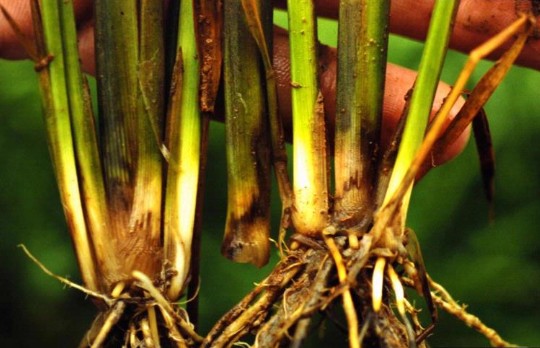Foot rot or bakane disease of rice
Causative agent: Fusarium moniliforme (Sexual stage: Gibberella fugikuroi).
- Seedborne fungal disease.
Symptoms:
- Infected seedlings have lesions on roots, and can die before transplanting or immediately after.
- Infected plants are several inches taller than normal plants. They are also thin, with yellowish green and pale green leaves.
- Check for white powdery growth at the base or on the lower portion of the infected plants.
- Check for roots growing from above-ground nodes on the stem.
- Early infection can cause seedlings to die at early tillering stage. Later infection results in plants that develop few tillers and have dry leaves. If the plants survive to maturity stage, they develop partially filled grains, sterile, or empty grains.

Etiology:
- Fungus produces both macroconidia and microconidia.
- Microconidia are hyaline, singlecelled and oval.
- Macroconidia are slightly sickle shaped, and two to five celled.
- The fungus produces the phytotoxin, fusaric acid, which is non-host specific.
Favorable condition:
- High humidity and cloudy weather during heading stage.
Survive and spread:
- Spreads mainly through air-borne conidiaand the fungus survives as parasite and saprophyte in the infected grains, plant debris and also on other crop debris.
Management:
- Use salt water to separate lightweight, infected seeds during soaking.
- Store the grains with 13.5-14% moisture content.
- Use fungicides as seed treatments
- benomyl or benomyl-t (at 1-2% of seed weight) for dry seed coating to treat infested seed can be effective. In cases where resistance to benomyl occurs, use a fungicide that contains triflumizole, propiconazole, prochloraz or a combination of thiram + benomyl.
- Spray the crop at boot leaf stage and at 50% flowering with Carbendazim + Mancozeb (1:1) @ 0.2%.